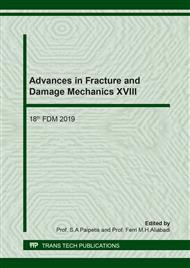p.1
p.7
p.13
p.19
p.25
p.31
p.37
p.43
Fibreglass Reinforced Polymer Structure Response under Different Impact Scenarios
Abstract:
Composite materials are increasingly used in those fields where it is necessary to achieve the requirements of lightweight and high mechanical properties. Even though their high specific strength which get these materials very attractive, especially for the transport field, there are several critical issues that still limit their application in primary structures. Among these, dynamic loading conditions play a critical role because they can significantly lower their residual strength. This paper aims to investigate experimentally the structural response of a 25 mm thick Omega composite structure under different impact loading conditions. The investigated test article consists of E-glass fibres (40% volume fraction) reinforced polyester matrix. The structure is covered by a HELIOPOL 1401 M AGC W 11 gelcoat layer and it has been impacted through a drop mass of 3.94 kg, dropped from heights of 50 mm, 75 mm, 100 mm, 150 mm, 200 mm, 250 mm, 350 mm and 500 mm.
Info:
Periodical:
Pages:
13-18
Citation:
Online since:
December 2019
Keywords:
Price:
Сopyright:
© 2020 Trans Tech Publications Ltd. All Rights Reserved
Share:
Citation:


